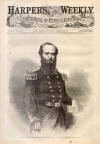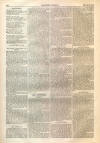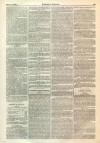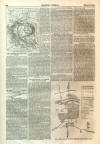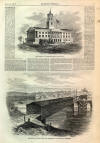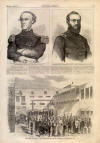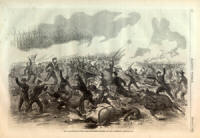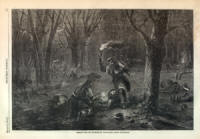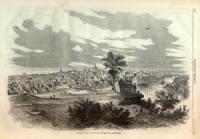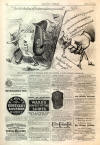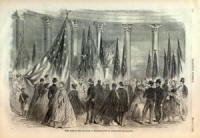Capitol Building, Nashville Tennessee
|
|
This Site:
|
MARCH 8, 1862.] HARPER'S WEEKLY. 153 THE CAPITOL AT NASHVILLE.—[FROM A PHOTOGRAPH.]NASHVILLE.ON page 152 we give a view of the CITY OF NASHVILLE, TENNESSEE, from a sketch kindly placed at our disposal by Mr. R. J. Meigs, a loyal citizen of Nashville, now resident in New York. It is, as every body knows, the capital of Tennessee, and is a fine city of about 20,000 inhabitants, situated on the Cumberland River.—Two bridges, a railroad bridge (M'Callumtruss), and an iron suspension bridge, span the river opposite to the city. Nashville stands on a bluff on the south side of the river. It is surrounded by hills, which command it, and render its defense extremely difficult against an army approaching from various points. The large building of which we give a picture herewith is the CAPITOL OF TENNESSEE, a new and handsome structure. Governor Harris lives in a little shanty opposite the Capitol, which was used by the architects during its construction. He is too mean to take lodgings at a hotel.
We likewise append a view of the fine RAILROAD BRIDGE over the Cumberland, which report stated the rebels had destroyed. The following account of Nashville we take from the New York Herald: Nashville is the capital of Tennessee, and seat of justice of Davidson County. It is a city and port of entry, and is situated on the Cumberland River, two hundred miles above its junction with the Ohio. The population of Nashville before the rebellion was about 24,000, but has since much decreased. The city is chiefly built on the south side of the river, on the slopes and at the foot of a hill rising about two hundred feet above the water. The Cumberland is navigable for steamboats for fifty miles above the city, and by smaller boats to the falls, five hundred miles from its month. There are five railroads radiating from Nashville—viz., the Tennessee and Alabama, Louisville and Nashville, Memphis and Ohio, Hickman and Nashville Branch, Nashville and Chattanooga, and Nashville and Northwestern. The city is generally well built, and there are numerous imposing public and private buildings. One of the finest of the former is the new Capitol, situated on an eminence one hundred and seventy-five feet above the river, and constructed, inside and out, of a beautiful variety of fossiliferous limestone. It is three stories high, including the basement. At either end of the building there is an Ionic portico of eight columns, each four feet and a half in diameter, and over thirty-three feet high, and at the sides there are also porticoes of six columns each. A tower or cupola rises above the centre of the roof to the height of two hundred and six feet from the ground. It has a quadrangular rusticated base, forty-two feet high, surmounted by a circular cell, thirty-seven feet high and twenty-six feet in diameter, with eight fluted Corinthian columns, designed from the choragic monument of Lysicrates at Athens. The dimensions of the whole building are one hundred and thirty-eight by two hundred and thirty-eight feet, and the construction cost over one million of dollars. It is approached by four avenues, which rise from terrace to terrace by broad marble steps. The edifice is considered the handsomest State Capitol in the Union. The new Court House is a large building, on the public square, with an eight-columned Corinthian portico at each end, and a four-columned portico at each side. The State Bank is a handsome Doric building. Among the other permanent edifices are the jail, the penitentiary, theatre, Odd Fellows' and Masonic halls, City Hospital, university, and school-houses. There are two fine bridges over the Cumberland River—one a railroad bridge, of wood, with an immense draw two hundred and eighty feet, and two stationary spans, each two hundred feet. This bridge was finished in 1859, at a cost of $240,000. The other is a wire suspension bridge, of more than seven hundred feet span, and one hundred and ten feet above the water. It was begun in 1850, and cost about $100,000. The city water-works were constructed in 1833, and the total expense up to 1861 has been more than $500,000. The water is raised from the river to four reservoirs, which have an aggregate capacity of one million six hundred thousand gallons. Gas was introduced into the city in February, 1850. The commerce of Nashville is very large, being carried on by river and railroads, and by turnpike roads, to the construction of which the city has devoted a great deal of attention. The revenue of the port amounts to about $40,000 per annum; but the Government has not yet erected a Custom-house in the city. The average annual shipments are—30,000 bales of cotton, 6000 hogsheads of tobacco, 2,000,000 bushels of wheat, 6,000,000 bushels of Indian corn, 10,000 casks of bacon, 25,000 hogs, and 2500 tierces of lard. The neighborhood of Nashville is a famous stock-raising country, and has a high reputation for blood-horses, jackasses, mules, cattle, sheep, hogs, and Cashmere goats. The leading business of the city is in dry goods, hardware, drugs, and groceries. Book publishing is carried on more extensively than in any other Western town, and the publishing house of the Southern Methodist Conference is one of the largest book manufactories in the United States. The manufactures are lees important than the commercial interests. There are three flour mills, eight or ten planing mills, and eight or ten machine shops. The value of the taxable property here is $15,000,000. Seven miles from the city is the State Lunatic Asylum, and twelve miles east is the Hermitage, the celebrated residence of Andrew Jackson. The municipal government is vested in a mayor, eight aldermen, and sixteen councilmen. The first permanent settlement was made in 1778-'80; the town was incorporated in 1784, received its charter in 1806, and was made the State capital in 1812. Nashville is 280 miles northeast of Memphis, 206 miles southwest of Lexington in Kentucky, and 684 miles from Washington city. At the hour we close this record the telegraph reports that the gun-boats and General Buell reached Nashville late last week, and that the city surrendered. THE RAILROAD BRIDGE OVER THE CUMBERLAND, AT NASHVILLE, TENNESSEE.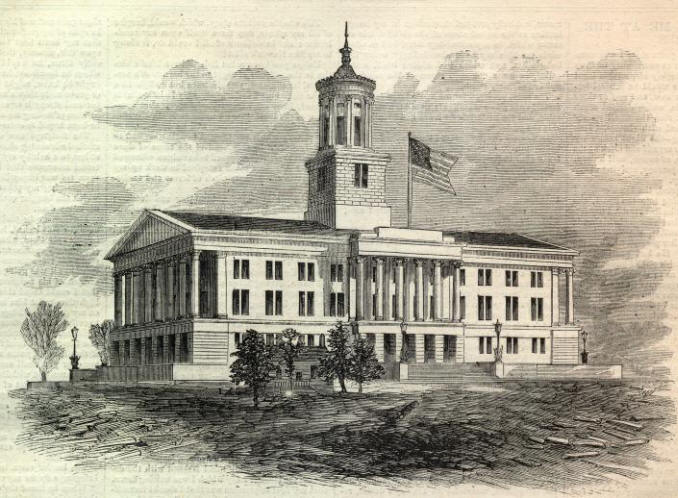 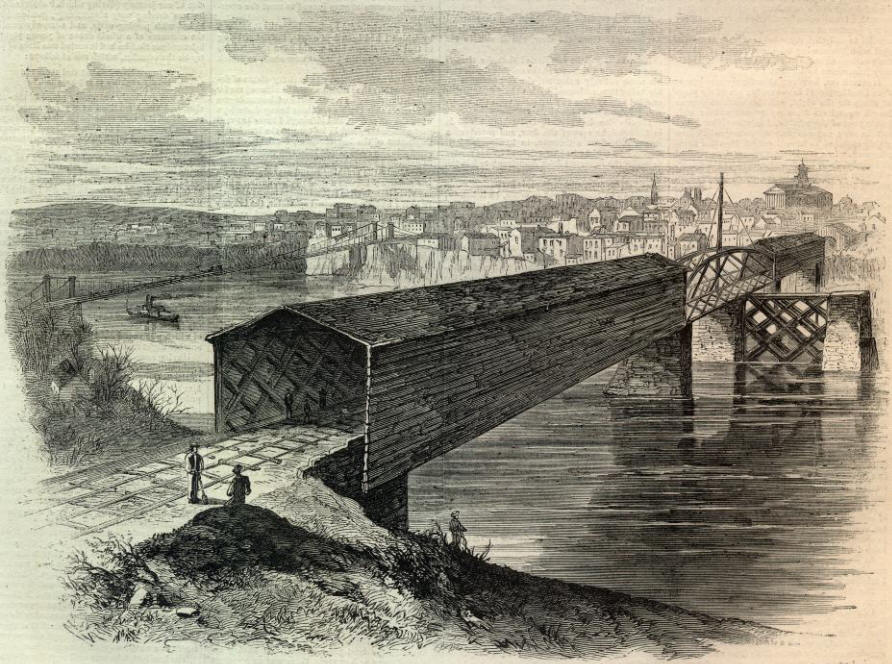 |
||||||||||||||||||||||||||||
|
|
||
|
|
Site Copyright 2003-2018 Son of the South. For Questions or comments about this collection, contact paul@sonofthesouth.net |
|
|
Are you Scared and Confused? Read My Snake Story, a story of hope and encouragement, to help you face your fears. |
||
